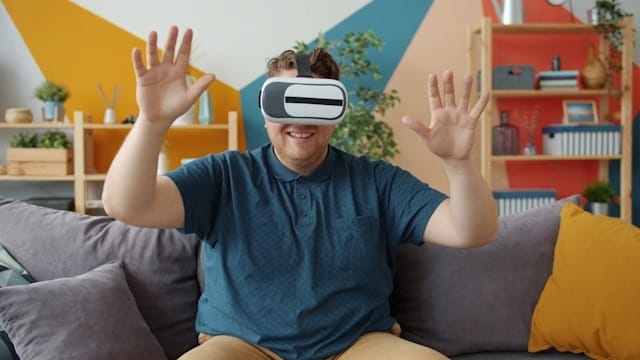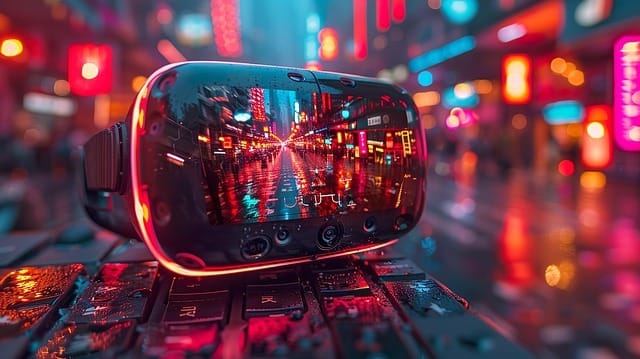Virtual Reality in Tourism: The Technology Transforming Travel
Imagine slipping on a headset and suddenly walking along the sunlit canals of Venice. Gondolas drift past, voices echo in Italian, and the golden light reflects off the rippling water. You remove your headset and realize you’ve never left your living room. That’s the transformative power of Virtual Reality in tourism.
For travelers, VR offers the opportunity to experience a destination virtually from the comfort of your home. In this article, we will explore Virtual Reality in tourism, how it benefits both travelers and businesses, and the cutting-edge tools driving this revolution.
What is Virtual Reality in Travel?
Virtual Reality in tourism uses digital simulations to recreate real-world environments, offering an immersive travel experience through VR headsets or platforms. Instead of simply watching a video or browsing photos, travelers can virtually walk through a city, stand beneath a waterfall, or step inside a historical landmark as if they were actually there.
Using VR headsets like the Meta Quest 3, HTC Vive, or even mobile-compatible devices, users can walk through hotel rooms, explore city streets, or visit iconic landmarks. These experiences are created using 360° videos, 3D rendering, and interactive storytelling, providing a vivid sense of place that engages the traveler's senses and emotions.
Benefits of Virtual Reality in Tourism
For tourism businesses, Virtual Reality in tourism offers powerful tools to attract, engage, and convert modern travelers. As customer expectations evolve, VR enables businesses to create immersive, memorable, and trust-building experiences that go far beyond traditional marketing.
Here are the key benefits tourism businesses gain from Virtual Reality (VR):

1. Showcase Destinations Through Immersive Previews
VR allows businesses to give potential travelers a realistic preview of destinations, accommodations, and attractions. By offering an immersive travel experience, businesses help customers visualize their trip, increasing emotional engagement and booking confidence.
2. Increase Conversion Rates with Interactive Marketing
Immersive experiences build confidence and reduce hesitation. When travelers can explore a destination virtually, they’re more likely to make a booking decision, which increases conversion rates and shortens the sales cycle.
3. Enhance Accessibility and Reach New Audiences
Not every traveler can visit a destination in person. Through VR technology in tourism, businesses can reach audiences with physical limitations, budget constraints, or geographic barriers, expanding their market beyond traditional boundaries.
4. Reduce Booking Uncertainty and Cancellations
By providing detailed, virtual previews of rooms, tours, or attractions, tourism businesses set realistic expectations. This transparency reduces post-booking dissatisfaction and cancellation rates, while improving customer satisfaction and trust in the brand.
5. Build Stronger Emotional Connections with the Brand
Immersive travel experiences leave lasting impressions. When customers explore a destination in VR, they form a more profound emotional attachment to the brand, turning interest into intent and intent into loyalty.
6. Strengthen Training and Operational Efficiency
Beyond customer engagement, VR offers a cost-effective way for tourism businesses to train their employees. Simulated hospitality scenarios allow teams to practice customer service, safety procedures, and crisis management in realistic, risk-free environments.
7. Promote Sustainable and Responsible Tourism
Using VR for destination marketing reduces the environmental impact of physical site visits for promotional shoots or events. It supports sustainability goals while aligning the brand with eco-conscious travelers and global tourism standards set by the UNWTO.
8. Stand Out in a Competitive Market
In a crowded tourism landscape, innovation sets businesses apart. Integrating VR travel experiences into marketing strategy demonstrates leadership, attracts tech-savvy travelers, and positions the business at the forefront of the industry’s digital transformation.
VR Applications in the Travel Industry
As the demand for digital innovation grows, Virtual Reality in tourism is transforming how businesses attract, inform, and delight travelers. Let’s explore how tourism businesses can apply VR technology in tourism to create impactful experiences and stay ahead in an increasingly competitive market.
1. Virtual Destination Previews
Travel agencies and tourism boards use VR to showcase destinations through 360° videos and interactive guides. Users can “try out” a safari in Kenya or stroll through Tokyo’s Shibuya Crossing before committing to a trip.
2. Hotel and Accommodation Tours
Many hotel chains, including Marriott International, use VR room tours to give potential guests a feel for their properties. This helps users visualize amenities, layouts, and views, making booking decisions easier.
3. Virtual Museum and Heritage Tours
Cultural heritage organizations like the British Museum and the Smithsonian Institution have adopted VR to make their collections accessible worldwide. Through VR, travelers can experience art, history, and culture without geographic limits.
4. Virtual Reality Events and Attractions
Tourist attractions such as Disney and Universal Studios integrate VR into rides and exhibits to enhance storytelling and engagement, blending physical and virtual realities for richer experiences.
5. VR Training for Tourism Staff
Beyond customer experiences, VR supports employee training in hospitality and tourism. It allows staff to practice emergency scenarios or customer service skills in safe, simulated environments.
6. VR-Powered Travel Marketing Campaigns
Replace traditional brochures and static ads with dynamic VR storytelling. From virtual safaris to simulated city experiences, VR marketing enables businesses to connect emotionally with potential travelers, boosting engagement and recall. Brands using immersive marketing report higher ROI and stronger customer loyalty.
Real-World Examples of Successful VR Implementation in Tourism
Numerous global organizations have leveraged VR technology in tourism to enhance engagement and sales. Here are a few examples of the application of VR technology in tourism:

1. Thomas Cook’s “Try Before You Fly”
Travel company Thomas Cook launched a campaign allowing customers to experience destinations like New York and Egypt through VR headsets in-store. The result? A 190% increase in bookings for featured destinations.
2. VisitScotland’s “ScotlandVR” App
VisitScotland’s “ScotlandVR” app lets users virtually explore landmarks like Edinburgh Castle and the Isle of Skye in 360°. The immersive experience sparked global interest and increased real-world visits by showcasing Scotland’s beauty before travelers even arrived.
3. Marriott’s “Teleporter” Booth
Marriott Hotels introduced “The Teleporter,” a VR booth simulating destinations like Hawaii and London. Guests could feel virtual wind, heat, and mist, bridging the gap between imagination and reality.
4. Dubai Tourism’s VR City Tours
Dubai’s Department of Tourism developed immersive VR experiences featuring landmarks such as the Burj Khalifa and Palm Jumeirah. These experiences increased engagement among potential travelers and showcased Dubai’s commitment to digital innovation.
Boosting Engagement for Tourism Businesses Using VR
In an age where digital engagement defines customer decisions, VR technology in tourism has become a game-changer for marketing and branding. Businesses are no longer just showing customers a destination; they are letting them experience it.
1. Virtual Storytelling and Destination Marketing
Traditional travel marketing relies on visuals and descriptions. With VR, tourism brands can craft immersive travel experiences that captivate emotions. When a potential traveler walks through a virtual rainforest or sits on a simulated beach, the emotional impact is far stronger than any photo.
Tourism brands like Qantas Airways and TUI Group use virtual storytelling to engage audiences on social media and through digital campaigns. These experiences encourage users to imagine themselves within the scene, increasing conversions and travel intent.
2. Virtual Reality Exhibitions and Fairs
Travel expos and events have gone digital with VR. Instead of attending a physical fair, users can explore virtual booths, interact with destinations, and even chat with agents within a 3D space. This innovation reduces costs while expanding global reach.
3. Increasing Brand Loyalty
Customers who experience destinations virtually before visiting feel more connected to the brand. VR provides a sense of transparency and excitement, improving trust and long-term loyalty. For travel agencies, offering virtual previews can lead to repeat bookings and referrals.
Technological Tools and Platforms in VR Tourism
To deliver seamless immersive travel experiences, tourism operators rely on cutting-edge VR tools and platforms. Here are some key technologies powering this transformation:
1. VR Headsets and Hardware
Devices like Meta Quest 3, HTC Vive, and Sony PlayStation VR2 offer high-quality visuals, motion tracking, and interactive experiences. These headsets allow users to explore 360° environments with realistic depth and movement.
2. 360° Cameras and Drones
Capturing destinations in 360 degrees helps create hyper-realistic simulations. Drones provide aerial perspectives of landmarks, mountains, or beaches, ideal for VR travel planning and promotional videos.
3. Software Platforms and Engines
Game engines such as Unity and Unreal Engine enable developers to build detailed VR worlds. Platforms like Google Earth VR and YouVisit offer virtual tours, letting users explore global locations interactively.
4. Augmented and Mixed Reality Integration
Mixed Reality (MR) combines the physical and digital worlds, enhancing VR experiences further. MR allows users to interact with virtual elements in real environments, paving the way for hybrid tourism solutions that blend real-world travel with digital immersion.
5. Cloud and AI Technology
Cloud-based systems store vast amounts of VR content, making it accessible from anywhere. Artificial intelligence enhances personalization, recommending destinations and activities based on user behavior and preferences.
Challenges of Virtual Reality Tourism
While VR technology in tourism offers vast potential, it also faces several challenges that the industry must overcome.
1. High Development Costs
Creating high-quality VR content requires significant investment in equipment, software, and skilled developers. For small tourism businesses, these costs can be prohibitive.
2. Limited Accessibility
Although headset prices are decreasing, not everyone owns a VR device. This limits audience reach, especially in emerging markets.
3. Motion Sickness and User Comfort
Extended VR sessions can cause motion sickness or eye strain for some users. Developers are addressing this with smoother frame rates and better motion-tracking technology, but it remains a concern.
4. Authenticity vs. Simulation
While VR can replicate experiences beautifully, it cannot fully replace the sensory, emotional, and cultural depth of actual travel. Balancing realism and expectation is critical to avoid disappointing travelers.
5. Data Privacy and Security
As with all digital tools, protecting user data is vital. Tourism companies must ensure compliance with data protection regulations like GDPR when collecting behavioral insights from VR interactions.
The Future of Virtual Reality Travel
The future of VR in tourism promises deeper integration between physical travel and digital simulation. As hardware becomes more affordable and content creation tools improve, VR will evolve from a novelty into a mainstream service across the travel ecosystem.
Here’s how Virtual Reality is set to redefine the future of travel and transform how businesses connect with tomorrow’s travelers:
1. Personalized Travel Planning
AI-driven VR experiences will let travelers “build” their ideal vacation by dynamically choosing destinations, hotels, and activities. Their VR preferences could sync with booking platforms, making the entire journey seamless.
2. Virtual Group Travel
With advancements in social VR platforms like Horizon Worlds, travelers will soon be able to explore virtual destinations together. They can plan group trips, attend virtual festivals, or even join guided tours from different parts of the world.
3. Sustainable Tourism Growth
As sustainability becomes a global priority, VR will support eco-friendly exploration. Virtual previews reduce unnecessary travel and promote responsible tourism practices aligned with global sustainability goals.
4. Integration with Mixed Reality
Mixed Reality (MR) will bridge virtual and real environments. Imagine walking through Rome while the headset overlays historical reconstructions on modern ruins. Such innovation will redefine travel education and exploration.
Conclusion
As Virtual Reality continues to evolve, it opens up exciting possibilities for enhancing travel experiences, from immersive destination previews to virtual tours of remote and hard-to-reach locations. VR has the potential to transform how we plan, experience, and even dream of travel, offering not just convenience but also a deeper connection to the places and cultures we explore.
Reach and inspire travelers like never before with immersive advertising. Create captivating virtual experiences with Flam that bring your destinations to life and drive real-world engagement.